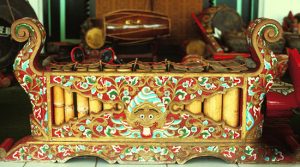Acquired: during the Reign of Sultan Hamengku Buwana V
Type of Gamelan: common practice–pre-modern
Tuning: sléndro

This eye-catching gamelan was made in the second quarter of the 19th century during the reign of the Fifth Sultan. During the late 19th and early 20th centuries, K.K. Pusparana (“flower battle”) had a specific, high-profile use during two of the three yearly Islamic celebrations (grebeg). For Grebeg Puasa and Grebeg Besar, K.K. Pusparana would be carried behind the palace guard unit known as prajurit Langenastra. Palace musicians would perform a specific piece, ketawang Gajahéndro (“Indra’s elephant”), as this set was carried in these colorful processions sponsored by the sultan.[1] Outside of these contexts, this gamelan was used to accompany dance and dance theatre in the palace along with the gamelan pélog K.K. Puspanadi (which is no longer in the possession of the palace). K.K. Pusparana was no longer being used in these capacities during the reign of the Ninth Sultan. The set probably remained in storage for the better part of fifty years until the late 1980s when a member of the royal family (G.B.P.H. Joyokusuma) began using it at his residence, where receptions are hosted that include meals and entertainment for the guests. This gamelan is identified as K.K. Retno Puspa (“gem flower”) at dalem Joyokusuma, and on a nearby plaque the set is attributed to the Second Sultan and is associated with a gamelan pélog in the Raffles Museum in England. This information is questionable on a number of fronts. I have never seen reference in any source of a Kraton Yogyakarta gamelan by this name. There is no Raffles Museum in England, although Sir Thomas Raffles did ship two gamelans from Java to England around the time of the Second Sultan. The origins in Java of those sets, one in the British Museum and the other in Claydon House, is far from certain, as is even their laras–they are apparently neither pélog nor sléndro, but diatonic. Finally, since 1999, G.B.P.H. Yudhaningrat, the head of the Kraton Yogyakarta performing arts office, has consistently identified this set as K.K. Pusparana in conversations with me. Therefore, in my opinion the identification of this set as K.K. Retno Puspa is spurious.
K.K. Pusparana remains the only common practice gamelan in the palace that has yet to be modernized (i.e., it retains its original mid-19th c. instrumentation). Perhaps something happened to its original gong ageng and kempul, for all of the vertically-suspended gongs now in this set were previously in other sets–the gong ageng is from K.K. Medharsih; of the two gong siyem one is from K.K. Marikangen and the other from K.K. Riya (a gamelan no longer in the palace); and the kempul from an unidentified set). In 2007 I asked G.B.P.H. Yudhaningrat, younger brother of Sultan H.B. X and head of the palace’s performing arts division, if there were plans to modernize this set. According to him there is an issue with the condition of the bronze of this gamelan that puts into question its longevity, therefore making it an unlikely candidate for a costly modernization project.
K.K. Pusparana is one of the most visually striking sets in the possession of the palace. Painted a dark red (abrit sepuh) with gold trim, the surfaces of this set are filled with vividly rendered plant tendrils (lunglungan) and a striking turbaned kedhok framed by mirong. A stylized sawat is carved and painted on each of the shoulders of all saron, slentho, and gambang gangsa casings of this gamelan. The vegetation, sawat, and kedhok are brought to life with sunggingan (in the style of the detailed painting found on shadow puppets) in a mixture of secondary colors: white, blue, green, gold, black, and light red.
Inventory:
gong ageng (1)
gong siyem/suwukan (2)
kempul (1)
kenong jaler (2)
kenong japan (1)
kethuk (1)
bonang penembung (1)
bonang barung (1)
bonang penerus (1)
saron demung (2)
saron ricik/barung (4)
slentho (1)
gendèr barung (1)
gambang gongsa/gangsa (1)
gambang kayu (1)
kendhang ageng/gendhing (1)
kendhang ketipung (1)
kendhang alit/batangan (general use instrument shared with other gamelans)
suling (general use instrument shared with other gamelans)
bendhé (general use instrument shared with other gamelans)
bedhug (general use instrument shared with other gamelans)
rebab (general use instrument shared with other gamelans)
siter (general use instrument shared with other gamelans)
kecèr (general use instrument shared with other gamelans)
keprak (general use instrument shared with other gamelans)


